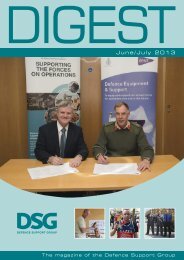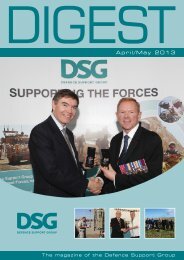Contents
December/January 2011 - Defence Support Group
December/January 2011 - Defence Support Group
- No tags were found...
Create successful ePaper yourself
Turn your PDF publications into a flip-book with our unique Google optimized e-Paper software.
news<br />
The EMC Chamber –<br />
one of Bovington’s<br />
hidden assets<br />
Challenger 2 in the EMCC<br />
It is not common knowledge<br />
that one of the buildings at<br />
DSG Bovington houses an<br />
Electro-Magnetic Compatibility<br />
Chamber (EMCC). This facility<br />
enables measurements to be<br />
made of electrical emissions<br />
from the equipment fitted into<br />
vehicles that might otherwise<br />
cause problems.<br />
Electro-magnetic radiation often causes<br />
interference, particularly when rapidlychanging<br />
electrical currents are produced<br />
by on-board equipment.<br />
There is an increasing amount of<br />
electronic and electrical devices being<br />
fitted into military vehicles such as<br />
sensors, air conditioning, computers and<br />
weapons systems, as well as engine<br />
ignition and management systems. It is<br />
important that they all operate together<br />
compatibly and particularly that they do<br />
not interfere with the vehicle’s own radio<br />
communications. The process also<br />
eliminates the emission of electronic<br />
noise, which could give away the vehicle’s<br />
location in a hostile environment.<br />
Constructed in 1992, it was the second<br />
largest EMCC in Europe at that time.<br />
Measuring 18.5 metres square, with a<br />
height of seven metres, it is still one of the<br />
biggest facilities of its type in regular use.<br />
As well as being physically big, the<br />
chamber has a strengthened floor,<br />
enabling it to take loads of up to 70 tons.<br />
Three different standards of measurement<br />
are applied - DRE01, DRE03 and MVEE<br />
595. Each one uses different antenna and<br />
measuring parameters. MVEE 595 is the<br />
test most commonly carried out, as it<br />
specifically covers the frequency range of<br />
standard military communications (HF 2 –<br />
30Mhz and VHF 30 – 76Mhz).<br />
Measurements taken by detectors flag up<br />
whether or not predetermined pass limits<br />
are achieved.<br />
When there is a high emission or a<br />
problem, the culprit can be identified and<br />
remedial action taken. This usually means<br />
adjusting the equipment, changing<br />
components, improving its earthing, or<br />
bonding to enable re-testing to take place.<br />
Bovington use the EMCC for suppression<br />
checks on Challenger tanks, Challenger<br />
Armoured Repair and Recovery Vehicles<br />
and vehicles coming through on<br />
programmed Economical Base Repair, but<br />
it is also open to other users. Facility<br />
Manager Steve Payne told Digest, “The<br />
Bovington EMCC is available for use by<br />
other Business Streams within DSG as<br />
well as other parts of the MOD or the<br />
Defence Industry. At one time or another<br />
most of the standard range of in-service<br />
military vehicles have been through the<br />
chamber, but other types to have been<br />
tested in the EMCC include prototype<br />
police cars, fire engines and 4x4 vehicles.”<br />
“<br />
The Bovington<br />
EMCC is available for<br />
use by other Business<br />
Streams within DSG<br />
as well as other parts<br />
of the MOD or the<br />
Defence Industry.<br />
”<br />
www.dsg.mod.uk December/January 2011 DIGEST<br />
17
















